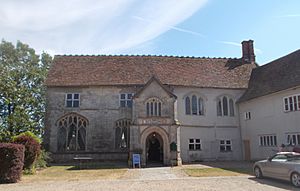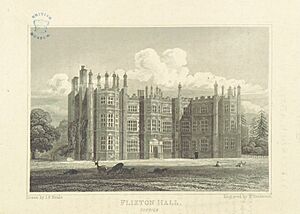Thomas Tasburgh facts for kids
Thomas Tasburgh (born around 1553, died around 1602) was an important English gentleman during the time of Queen Elizabeth I. He came from South Elmham in Suffolk and later lived in Buckinghamshire.
Thomas held many important jobs. He was a magistrate (a type of judge), a Member of Parliament (meaning he helped make laws), and the High Sheriff of Buckinghamshire (a top law enforcement officer for the county). He also worked for the Queen as an officer in the Exchequer, which managed the country's money.
Even though Thomas Tasburgh was not a Catholic recusant himself (someone who refused to attend Church of England services), his second marriage connected him to many Catholic families. His stepdaughter, Lettice, later married his nephew, John Tasburgh (V). This marriage helped shape the future of the Tasburgh family's Catholic faith.
Contents
Thomas Tasburgh's Family Background
Thomas Tasburgh's family got their name from the village of Tasburgh in Norfolk. They later settled in Suffolk. His father, John Tasburgh (III), bought the land where Flixton Priory used to be and lived there.
John Tasburgh (III) was married twice. His first wife was Alice Dybney, and they had three sons: John, Owen, and William. Thomas Tasburgh was born from his father's second marriage to Elizabeth Davy. Thomas might have been born after his father passed away.
After John Tasburgh (III) died, Thomas's mother, Elizabeth, had to deal with her husband's debts. She remarried twice. Thomas's older half-brother, John Tasburgh (IV), later took over the family estates at Flixton. He paid Thomas a yearly amount of money. Thomas went to study law at Gray's Inn in London.
Thomas's First Marriage
Thomas Tasburgh first married Dorothy Kitson (1531–1577). Dorothy was the daughter of Sir Thomas Kitson, who built the famous Hengrave Hall in Suffolk. Dorothy had been married before to Sir Thomas Pakington.
This meant Thomas became the stepfather to Sir John Pakington, who was a favorite at the royal court. Interestingly, John Pakington was a little older than Thomas, even though Thomas was his stepfather! Dorothy Pakington was known for trying to appoint two representatives for the town of Aylesbury herself after her first husband died.
Thomas and Dorothy bought a property called Hawridge in Buckinghamshire. They did not have any children together. Dorothy passed away in 1577 and was buried at Hawridge. Her memorial stone has an inscription that says:
"Here lies buried the body of Dame Dorothie Pakyngton, a daughter of Sir Thomas Kytson, late of London, knight. She was first the wife of Sir Thomas Pakyngton, knight, and last of Thomas Tasburgh, Esquire. She lived very virtuously and passed away as a most faithful and godly Christian on the 2nd of May, when she had lived 46 years and 7 months, in the year 1577."
After Dorothy's death, Thomas continued his public service. He became a Justice of the Peace for Buckinghamshire in 1579. He was also the High Sheriff of Buckinghamshire from 1581 to 1582. He was elected as a Member of Parliament for Aylesbury in 1584 and 1586, and for Buckinghamshire in 1588.
Thomas's Second Marriage
On January 16, 1588, Thomas married for the second time to Jane West. Jane was the daughter of William West, 1st Baron De La Warr. She had been married twice before. Her first husband was Thomas Wenman, and her second was James Cressy.
Jane brought children from her previous marriages, but Thomas and Jane did not have any children together. Through this marriage, Thomas gained more properties, including the manor of Twyford and Wilton in Beaconsfield. The Wenman family, Jane's first husband's family, had Catholic sympathies. It is said that Jane's second husband, James Cressy, became Catholic and then converted her.
This marriage also brought some financial challenges for Thomas. He had to deal with debts that Jane's previous husband, James Cressy, owed to the Crown.
Later Life and Career
Thomas continued his work in Parliament, representing Chipping Wycombe in 1593. Around this time, some of his properties were taken by the Crown because of laws against Catholics, even though he was not a Catholic himself.
In 1595, Thomas was questioned because his neighbor accused him and his wife of supporting Catholicism and being married by a Catholic priest. Thomas explained that he was married by a minister in Twyford and denied having any forbidden religious items. His neighbor apologized, saying his wife was upset because Thomas had questioned her husband's business.
Since Thomas and Jane had no children together, they chose Thomas's nephew, John Tasburgh (V), as their heir. In 1597, John (V) married Lettice Cressy, who was Jane's daughter from her second marriage. Thomas and Jane gave Hawridge to John (V) at this time. This might have been to protect the property from strict laws against Catholics.
Thomas served in Parliament for Aylesbury again in 1597. The next year, he was appointed as one of the four Tellers of the Exchequer, a very important financial role for the Queen.
In May 1599, Thomas traveled to Dublin, Ireland, and was knighted by the Earl of Essex. However, Queen Elizabeth I was not happy about his trip. When he returned to England, he was put in prison. Thomas wrote letters to Sir Robert Cecil, asking for his help with the Queen. He explained that he had only meant to go a short distance with the Earl of Essex but was persuaded to stay longer. He reminded the Queen of his nearly 30 years of loyal service.
While in prison, Thomas worried he would lose his important job at the Exchequer. He insisted he did not seek the knighthood and was told the Earl had the Queen's permission to give it. Thomas kept his position in the Exchequer until he passed away.
Supporting the Arts
In 1602, a poet named William Basse published a book of poems called Three Pastoral Elegies. He dedicated this book to "The Honourable and Virtuous Lady, the Lady Tasburgh," which was Jane, Thomas's wife. It is thought that Basse had worked for Jane's first husband's family.
The poems are about a shepherd boy who admires a young man in love. The boy helps the young man declare his love to a beautiful lady. The lady kindly turns down the love, but her grace makes the messenger fall in love with her. The dedication from the poet to Lady Tasburgh also talks about money and debts, perhaps hinting at her family's financial situation.
Death and What He Left Behind
Thomas Tasburgh died suddenly in early 1603 and was buried in London. After his death, it was found that he owed a large amount of money to the Crown from his time as a Teller of the Exchequer. In his will, he left Hawridge to his nephew, John Tasburgh (V).
In 1605, after the Gunpowder Plot (a famous attempt to blow up Parliament), Lady Jane Tasburgh caused some trouble by sharing letters that seemed to be about treason. This led to many questions and investigations. Around this time, new, very strict laws against Catholics were introduced.
Around 1605, Dame Jane married for a fourth time to Ralph Sheldon, a strong supporter of the Catholic faith. Jane was still referred to as "Lady Jane Tasborough." She passed away in 1621. The Catholic faith of the Tasburgh family in later years seems to have been strongly influenced by Lettice Tasburgh (Jane's daughter and Thomas's stepdaughter) and her family.




